Driving the Ha Giang Loop By Yourself: The Full Guide (2024)
In the far north of Vietnam, there is a region so remote, that even the French once gave up on controlling it, instead building a gate to seal the region off: Ha Giang Province.
The winding roads present stunning scenery and a wonderful motorcycle trip opportunity in what has become the Ha Giang Loop.

For good or for bad, The Loop is rapidly gaining popularity among backpackers and adventurers, both experienced motorcycle drivers and total newbies.
If you’re considering the Ha Giang Loop by yourself, regardless if you’re experienced and have all the documents, or are planning to ride a motorcycle there for the first time, you should be prepared. So here it is.
The Ha Giang Loop is part of my 1 month Vietnam backpacking itinerary.
Ha Giang Loop Quick Facts
- Time needed: 3-5 days
- Distance: 310 – 450 km
- Attractions: Dramatic landscapes, rice terraces, minority villages, authentic markets.
- Difficulty: 4/5
- Cost: ~650.000 VND (~26 USD) per day
How many days for the Ha Giang Loop?
The Ha Giang Loop is anywhere between 310 km and 450 km depending on the route you take and the number of detours. Going around takes on average 3-5 days.
- Anything under 3 days would be rushing it. You’d have to drive way too much per day and have little time to explore.
- Three days (2 nights) on the loop is fine and most people opt for this option. This amount of time will allow you to see the main sights, detour to Vietnam’s northernmost point and the famous flagpole, and have enough time at each notable place to soak in some of the unique cultures.
- Four days (3 nights) on the Ha Giang Loop allows you to drive between towns more leisurely with more time to explore. 4D/3N is my recommendation for the Ha Giang Loop.
- Five days (4 nights) will give you one extra night in an off-the-beaten-track village to relax in this unique region of Vietnam. If you’re into slow travel, go for the laid-back 5D4N option.
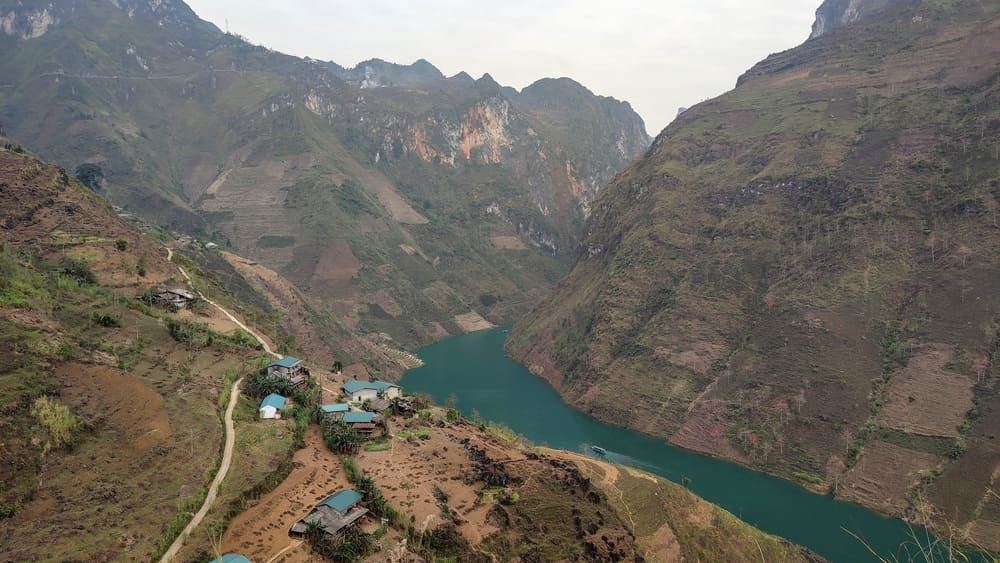
Ha Giang Loop 4-Day Itinerary
Here’s the standard 4-day Ha Giang Loop Route that will bring you to the main sights and give you enough time to visit all attractions:
- Day 1: Ha Giang to Yen Minh (95 km)
- Day 2: Yen Minh to Lung Cu to Dong Van (87 km)
- Day 3: Dong Van to Du Gia (100 km)
- Day 4: Du Gia to Ha Giang (70 km)
For a 3-day tour, drop Yen Minh and go straight to Dong Van on Day 1. Alternatively, just stop for a couple of hours at Du Gia, but don’t spend a night there.
For a 5-day tour, add an extra night at Lung Cu (night #2) or Meo Vac (night #3).
I don’t advise you to do the Ha Giang Loop in 2 days as that’s way too little time and you’ll end up glued to your motorcycle for the whole time.
The rest of this guide will explore the 4D/3N itinerary.
Day 1: Ha Giang to Yen Minh
Distance:
95 km
Driving time:
~3 hours
Notable stops:
- Bac Sum Pass
- Heaven’s Gate at Quan Ba
- Twin Mountains (Fairy Bosom)
Best backpacker accommodation:
Tom Homestay in Yen Minh
Assuming you’re starting the loop in Ha Giang City, you’d want to wake up early on your day 1 and leave Ha Giang before 8 AM. That’s to avoid both police checkpoints and traffic.
The standard route is to do the Ha Giang Loop clockwise. Drive north on the QL4C towards Yen Minh and Dong Van. The first notable stop is after 30 km at the Bac Sum Pass. In this 4-day guide, I will take you through the Ha Giang Loop clockwise.
Some people do the Loop counterclockwise. This may help avoid police checkpoints as the police usually stop people driving the other way. The choice is yours – it’s a loop, after all, so you will see the same places either way.
Bac Sum Pass
The first of many passes you’ll cross on the Ha Giang Loop. Bac Sum Pass offers cool views of corn and rice fields, banana plantations, and beautiful lush green meadows.
Stop at the top to take pictures of the scenery and buy a dragon fruit (Vietnam’s national fruit) from the local vendors.
Quan Ba Heaven’s Gate
Remember how I said the French thought the region was too remote to control and built a gate? That’s the gate in question.
Around 15 km after Bac Sum Pass, you’ll see the gate. Fifteen meters high, imposing, and made of 150 cm solid wood.
Except this is what the gate would’ve looked like in the 1940s. Today it doesn’t exist anymore.
Instead, you’ll see a sign saying “Cong Troi Quan Ba” where the gate formerly stood.
Now, don’t cry, you’re there for the views anyway and they are incredible!
Twin Mountains (Fairy Bosom)
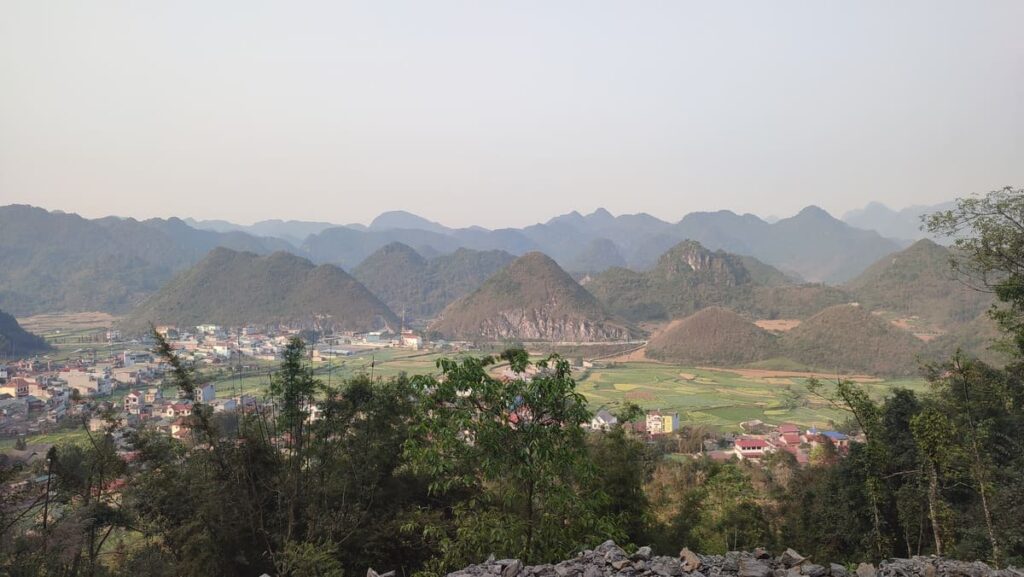
Not too far from Heaven’s Gate are two well-shaped identical mountains right next to each other in a way that, ahem, resembles the breasts of a giant woman. Weird name, right?
There’s a Hmong legend about a boy who whistled so enchantingly that a fairy fell in love with him. Unfortunately, the Jade Emperor found out and called the fairy back to the heavens.
The deed was already done though – there was a kid in the hands of that poor boy, so the fairy left her bosom there to nourish the baby.
Sleep in Yen Minh
Yen Minh is one of the larger towns in the region. It has ATMs, a gas station, and a few shops. There are plenty of places to sleep either in the town or in nearby villages.
For backpackers, my recommendation is Tom Homestay.
Day 2: Yen Minh to Lung Cu to Dong Van
Distance:
87 km
Driving time:
~3.5 hours
Notable stops:
- Tham Ma Pass and Chin Khoanh Ramp
- Lung Cam Cultural Village
- Hmong King Palace (Dinh Vua Mèo)
- Sa Phin Market
- Lung Cu Flag Pole
Best backpacker accommodation:
Tham Ma Pass and Chin Khoanh Ramp
Departing Yen Minh, you will be going steadily uphill for the next 15 km until you reach the top of Tham Ma Pass. There locals have improvised a small market for flowers around the viewpoint towards the buckwheat fields underneath. They call it the Chin Khoanh Ramp.
Some entrepreneurial older ladies might try charging you 10.000 to 20.000 VND (0.4-0.8$) for access to the viewpoints. Honestly, it’s up to you if you want to pay – you’d be supporting the locals (although it feels a bit scammy and Vietnam is famous for scams), but there are also plenty of free spots available.
Lung Cam Cultural Village
As you descend into the valley, you’ll see beautiful greenish-yellow fields of flowers and buckwheat. Buckwheat is the region’s main agricultural produce.
In Lung Cam, a tourist hotspot has formed around the community. I can’t judge to what extent this is an authentic village, but the fact that kids purposefully put baskets of flowers on their backs and charge for pictures settles it for me (i.e. not authentic at all).
If you decide to enter, you’ll have to pay a small fee of 10.000 VND (0.4$). I got enough just looking from the outside and munching on a sweet buckwheat cake.
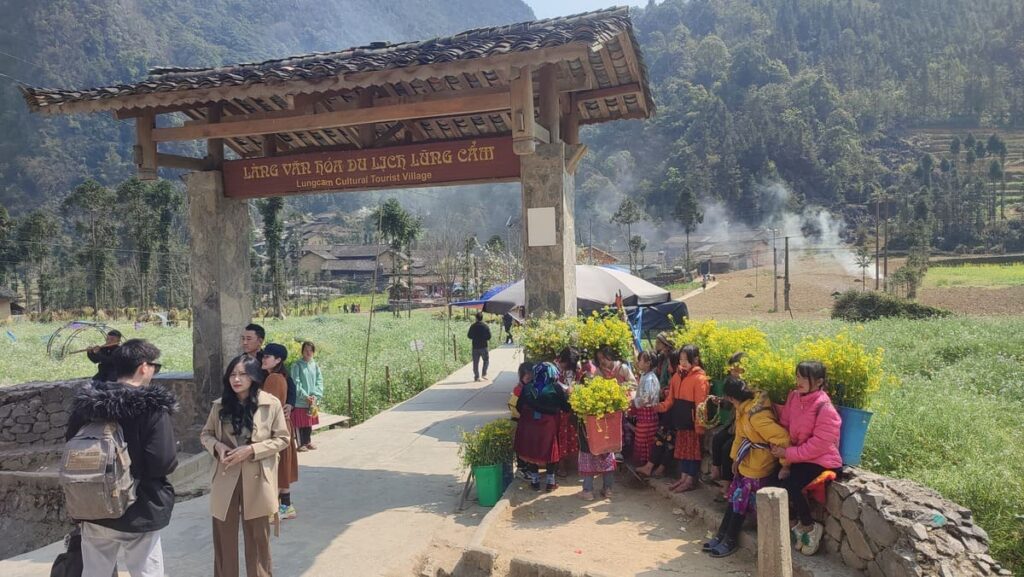
Hmong King Palace (Dinh Vua Mèo)
Just off Sa Phin is the former residence of the Hmong King.
The Hmong are an ethnic group from Northern Vietnam, Laos, and Southern China with their own distinct culture, traditions, clothing, and language. They ruled the region for a few centuries with a monopoly on the opium trade. Which is how the Hmong Kings could afford a magnificent palace.
What’s left of the Palace today is a bit underwhelming. Not much of the interior remains and there’s very, very little information in English. The price to enter is 30.000 VND / 1.27$. I say enter, but keep your expectations low.

Sa Phin Market
On the other side of the road from the Hmong Palace is the Sa Phin Market. It is unique that it’s a weekly backwards market, i.e. instead of being held on a fixed day, it’s every 6 days, so if this week it falls on Sunday, the next it’s on Saturday, then on Friday, and so on.
How to know what day it’s on? This is the real question, isn’t it? Unfortunately, there’s no information about it online, you just have to keep track of the calendar, I guess. As a tourist, your best bet is to ask your hostel in Ha Giang or locals around the area.
When I went there, it was not a market day and the bazaar was eerily empty.

Lung Cu Flag Pole
Instead of racing forward on the QL4C to Dong Van, turn left at Sa Phin towards Vietnam’s northernmost point. I found these roads to be the most beautiful in the region, so don’t miss the chance to explore some more of the Ha Giang countryside!
As you approach Lung Cu, you’ll be able to see the fenced border with China. There’s even a manned border post where you can take some pictures. Beware and ask first – taking pictures of borders is sometimes frowned upon. At this one, the guard was cool with it and even posed for selfies with some tourists.
I found Lung Cu itself to be very charming. It’s remote and rugged and the village-life vibe was to my liking.
Unfortunately, I can’t say the same about the tacky flag pole that is the ‘big’ attraction there. It’s something of a rite of passage for Vietnamese youth who come from all corners of the country. But it doesn’t really fit in Lung Cu.
There’s an entrance fee of 40.000 VND / 1.7$ to go up to the tower and the viewpoint.
My suggestion: skip the stupid flag pole and go to the Northernmost Point of Vietnam instead.

Drive to Dong Van and sleep there
Dong Van is about 1h drive from Lung Cu. If it’s getting late or you’re tired, I suggest you spend the night in Lung Cu. Some rustic homestays will make you feel like you’re far away from civilization.
For a budget traveler, I can recommend Lung Cu Homestay.
If you decide to drive and sleep at Dong Van, my recommendation for a hostel is Dong Van B&B.
Day 3: Dong Van to Du Gia
Distance:
100 km
Driving time:
~3.5 hours
Notable stops:
- Ma Pi Leng Pass
- Nho Que River
- Meo Vac
- Mau Due Viewpoint
Best backpacker accommodation:
If there’s a section of the Ha Giang Loop you’d want to do over and over again, let this be it. The road between Dong Van and Du Gia is the most picturesque and the most breathtaking.
Ma Pi Leng Pass
It all starts with a slow 11 km ascent toward Ma Pi Leng Pass. This road was constructed in the 1960s by minority groups in the region – mainly Hmong, Lolo, Tay, and Zhao. The name comes from the Hmong language and means “bridge of a horse’s nose“.
The road is incredibly important to the region. Before its completion, this section of the Ha Giang Loop was entirely cut off from the world. With the road came access to education, healthcare, trade, and of course – travel.
Crossing the pass might take you much longer than the distance suggests, as the views are simply incredible and will prompt you to stop multiple times for pictures.

Nho Que River
While the river is visible from the main road, venture down to take a short boat trip.
The road down to the river is 193A and starts about 5 km before Meo Vac. This detour is 4 km one-way and brings you to the boat tour ticket office.
A ticket for a boat tour on the Nho Que River costs 120.000 VND / 5$ and includes the bus from the ticket office to the boats.
The tour lasts about an hour and takes you all the way to under Ma Pi Leng Pass. You might have to queue for pictures at the front of the boat though – the annoyances of mass tourism.

Meo Vac
There isn’t much to see or do in Meo Vac, although it’s a nice little town where you can have lunch.
Make sure to check the local market. If you’re a dog lover, I suggest you don’t look closely at the meat. Speaking from experience.
Mau Due Viewpoint
From Meo Vac go on the DT182 road going south towards Du Gia. This road is significantly worse than the rest of the Ha Giang roads.
Slow down before turns, slow down even more if there’s sand or water on the road, and don’t take unnecessary risks. It’s not like I’m saying anything new here.
Just after the town of Mau Due, you will reach a nice viewpoint overlooking the valley and its rolling hills.

Drive into Du Gia to spend the night
Another 20 km from the viewpoint and you will be in Du Gia. It’s a very rustic village. There are no ATMs here, so make sure you get cash in Meo Vac or Dong Van.
The place with the best views in Du Gia is hands down Du Gia Field View Homestay. It’s quite cheap too! Definitely gets my vote!
Day 4: Du Gia to Ha Giang
Distance:
70 km
Driving time:
~2.5 hours
Notable stops:
- Du Gia Waterfall
- Ban Vai Viewpoint
Last day on the Loop, time to wrap it all up with some nice views and natural attractions. First off – a waterfall!
Du Gia Waterfall
The Du Gia Waterfall is just 15 minutes from the town. On Google Maps it’s called Thâm Luông Waterfall. Even though it’s quite close, you might still want to ask your guesthouse for directions as the roads in this region are unreliable. It’s always nice to have local insights.
At the waterfall, you can swim and jump from about 5 meters. It’s a nice place to relax before moving on for the day.

Ban Vai Viewpoint
From Du Gia some people go west towards Quan Ba again, passing through Duong Thuong and Lung Tam. While these places are indeed quite nice, I decided to go south to make it more of a loop. It’s the Ha Giang Loop after all right?
There is way less traffic than anywhere else between Du Gia and the QL34 in the south which is all the more reason to pick it. First stop: Ban Vai! Enjoy the same beautiful views as elsewhere in Ha Giang but without the crowds.
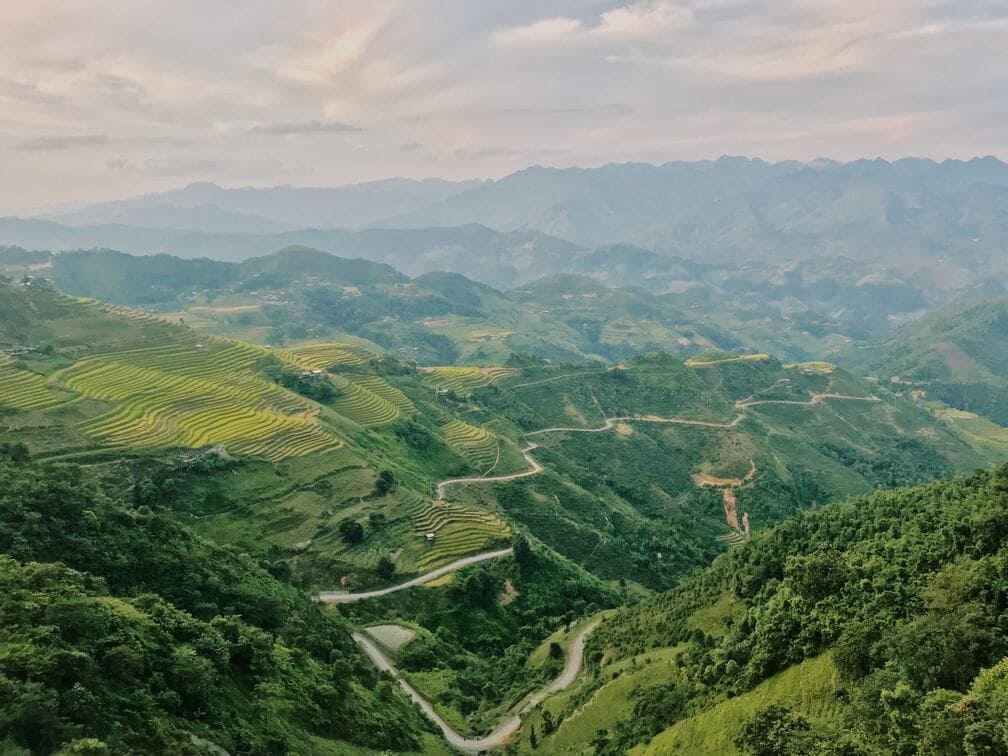
Towards Ha Giang
The road to Ha Giang is really pleasant to drive on. From Ban Vai to Na Sai there’s very little traffic and from Na Sai to Ha Giang the road conditions are very good. It’s the smoothest riding day and you can take as many stops as you wish.
My advice is to spend the night in Ha Giang and take the morning bus to Hanoi (or Sapa). If you’re short on time, you can take a sleeper bus to Hanoi, but since it only takes 7 hours, you’ll arrive in the middle of the night. Not ideal.
However, with the day bus, you will arrive during the day which gives you an amazing opportunity to go to one of these cooking classes in Hanoi.
How to get to Ha Giang
Ha Giang is in the extreme north of Vietnam. You can reach it within a day from the other popular tourism hotspots in North Vietnam – Hanoi and Sapa.
From Hanoi
Some people rent a motorcycle in Hanoi and ride to Ha Giang. I wouldn’t recommend that option. It would cost you 2 days extra (moneywise and timewise) and there isn’t any worthwhile scenery between the two cities. It’s just an exhausting 7-hour drive one way.
Why do that, when you can comfortably relax in a Vietnamese sleeper bus? Any hostel or tour operator in Hanoi can book a ticket for you.
Honestly, tourism in Vietnam has exploded to such an extent that travelers’ convenience is unprecedented. Tourism offices, hostels, and hotels all organize tickets and transfers at little or no extra cost.
The bus to the Ha Giang Loop from Hanoi costs ~250.000 VND / 10.7$ and takes 7 hours. You can travel during the day or through the night. The overnight one arrives before sunrise leaving you exhausted in the cold – I don’t recommend it.

From Sapa
There’s a daily minibus from Sapa to Ha Giang. It’s not a sleeper-style bus and given the road conditions, isn’t the most comfortable. But it’s bearable. It costs 300.000 VND / 12.7$ and takes 6-7 hours.
You can easily book that through your hostel in Sapa.

Where to sleep on the Ha Giang Loop
Depending on how you plan your Loop adventure, you’ll probably be sleeping in Yen Minh, Lung Cu, Dong Van, Meo Vac, and/or Du Gia.
| Place on the Ha Giang Loop | My recommendation for budget backpackers |
|---|---|
| Ha Giang | Ha Giang Ali Hostel |
| Yen Minh | Tom Homestay |
| Lung Cu | Lung Cu Homestay |
| Dong Van | Dong Van B&B |
| Meo Vac | Lo Lo Homestay & Cafe Meo Vac |
| Du Gia | Du Gia Field View Homestay |
What is an “Easy Rider”?
Easy Rider is the general term used for when you are on the back of a motorcycle driven by an experienced driver. Many do the Ha Giang Loop this way, especially those inexperienced or not confident enough. You can either hire a private driver or join a tour.
The cost of hiring a private motorcycle driver on the loop is upwards of 800.000 VND / 34$ per day, and you must also pay for his/her food and accommodation.
Easy Rider tours generally go for a minimum of 2.500.000 VND / 106.5$ for a 3D/2N tour, inclusive of accommodation and food. However, most tours are offered more in the range of 4-5 million VND (170-210$).
If you’re an inexperienced driver, you should carefully consider an Easy Rider. Just because some reckless people do the Ha Giang Loop independently, doesn’t mean you should too.
Consider this awesome Easyrider Ha Giang tour instead (includes transport from/to Hanoi).
What bike to rent for the Ha Giang Loop?
There are many different motorcycles out there, but they all fall into three categories.
Scooters (fully automatic)
No, just no. Don’t ride a scooter on the Ha Giang Loop.
These are the bikes without gears where you just turn the handle and go. For one, it’s not possible to change down a gear to add more power to the bike, so you can go over steep sections.
Second, going downhill, you’re running the risk of overheating the brakes, as the engine can easily go into automatic and not help with controlling the speed at all.
Scooters are for cities, not for mountains.
Semi-automatic
This is the best choice for the Ha Giang Loop and the most common choice for riders.
Semi-auto bikes have gears but don’t have a clutch. Changing gears is easy and learnable in 20 minutes of practice. Gear will allow you to go up steep slopes and more easily control your speed going down.
The most common semi-auto bike in Vietnam is the Honda Blade 110 CC which has 4 gears.
Renting a semi-auto in Ha Giang costs around 150.000 to 200.000 VND (6.4 to 8.5$) per day.
Manual
Manual bikes are an excellent choice for the Ha Giang Loop. These bikes have both gears and a clutch allowing you maximum control. The most popular manual bike in Vietnam is the Honda XR 150 CC.
Renting a 150 CC manual bike costs around 350.000 VND / 15$ per day.
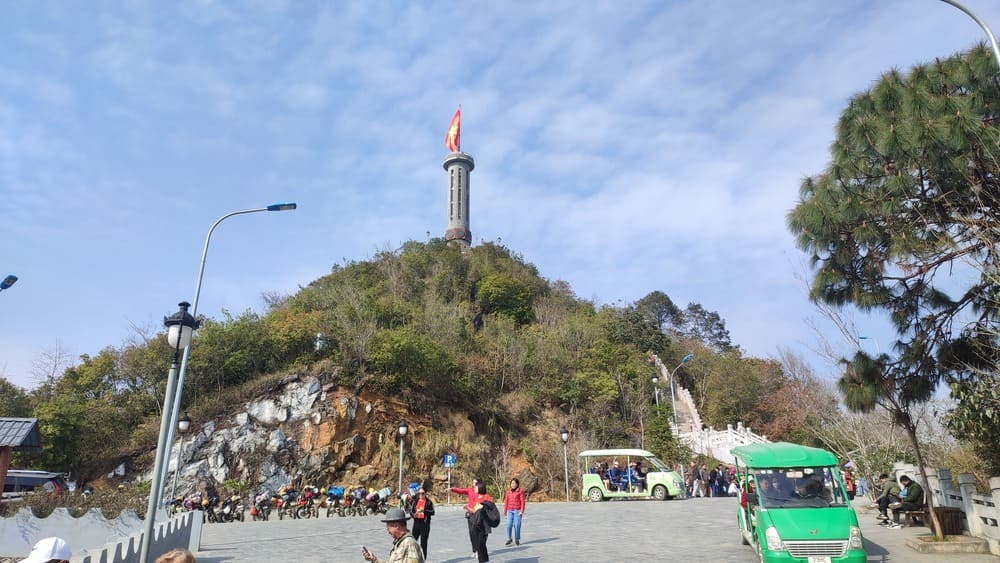
Renting a motorcycle in Ha Giang
You can rent a motorcycle pretty much anywhere in Ha Giang. Almost all hostels offer motorcycles for rent. You cannot walk more than 200 meters without seeing a rental shop there. This is Vietnam – a nation of 100 million with 70 million motorcycles.
I rented a semi-auto Honda Blade from my hostel – Ha Giang Ali Hostel and was very satisfied. The bike was new, I had no problems at all, and I knew that even if I had, I could rely on Mr. Ali to help me.
Rentals usually require that you leave your passport while renting the bike. It’s standard practice in Vietnam, like it or now. Give an ID card instead if you have one – rentals all across Vietnam have always accepted mine as a deposit.
Carry a photocopy of your passport on the Loop if you leave it in Ha Giang.
What documents do you need to drive legally on the Ha Giang Loop?
Legally speaking, to drive the Ha Giang Loop, you need:
- Ha Giang Loop Permit;
- Motorcycle Driver’s Licence;
- International Driver’s Licence from a country that has signed the 1968 Vienna Convention;
The Ha Giang Permit
Nobody cares about this one. Most people don’t even bother to obtain it. Yes, you are legally required to have it, but even police don’t ask to see it at road stops. But then again, you never know.
Nevertheless, if you want to be totally in the clear, head to the Ha Giang Immigration Office, pay the 230.000 VND / 9.8$, and get it in 30 minutes.
Motorcycle Driver’s Licence
That would be Category A on the Road Convention Classification. Category AM doesn’t cut it, as it’s only for motorcycles reaching max speed below 45 km/h.
Category A1 is also okay, as long as the motorcycle you rent is under 125CC.
International Driver’s Licence
Crucially, Vietnam has NOT signed the 1949 Vienna Convention on Road Traffic, only the 1968 one.
Thus, any country that has ratified the 1949 one, but not the 1968 one will produce an IDP invalid in Vietnam.
Examples of such countries are the USA, Canada, Australia, Singapore, New Zealand, Malaysia, Japan, Ireland, India, Argentina and many others.
If you have a 1949 IDP, then the only way to legally drive in Vietnam is to obtain a local driver’s license. It’s a complicated process and no wonder most people don’t bother with it.
Read all about obtaining a Temporary Vietnamese Driver’s Licence for Foreigners.
Insurance
There are two types of insurance that you want to have on the Ha Giang Loop: personal and motorcycle.
IMPORTANT: Your travel insurance WILL NOT cover you if you drive illegally. That also includes driving with a 1949 IDP.
Travel insurance when driving without a valid license is worthless.
Personal Insurance
That one is up to you. If you’re traveling, chances are that you already have one. Just make sure you are covered for traffic accidents in the insurance policy.
I use SafetyWing for my backpacking adventures and so far everything from support to claims has been a breeze!
Motorcycle Insurance
This one is offered by the motorcycle rental for an additional cost. Your travel insurance, depending on the policy, could cover you for third-party liability and property damage. Otherwise, I suggest you buy insurance from your renter.
Motorcycle insurance costs ~100.000 VND / 4.25$ per day but could be more depending on the coverage.
Police Checks on the Ha Giang Loop
In recent years police presence in Ha Giang has increased. Given that the Loop has started attracting many new riders, most of whom inexperienced newbies, and with a few fatal accidents every year, their presence is probably warranted.
Still, there’s very little police on the actual loop.
Most police stay at the exits and entrances of Ha Giang, sometimes also Meo Vac and Dong Van.
I didn’t see a single policeman in my four days of driving on the Ha Giang Loop.
Whether you’re driving legally or not, I suggest you do your best to avoid dealing with the police. On your day 1, wake up early and leave Ha Giang before 8 AM – that’s when the police start manning their posts. They usually stay here.
What to do if you have an accident
An accident on the Ha Giang Loop can mean anything from a light scratch on the motorcycle to death. You don’t want either, but let’s assume you’re physically okay after a crash. What now?
Call your rental. They have had this happen before and know what to do. They also speak Vietnamese, so they can communicate with whoever else was involved in the crash.
If there’s light damage to someone else’s car or motorcycle, you can probably get away by just paying a few hundred thousand Dong. They don’t want to call the police just as much as you, so chances are they will take the money.
If there’s damage to your bike, call your rental to discuss the next steps. Don’t repair the bike without consulting them first.
Fuel
Fuel costs around 25.000 VND / 1$ per liter on the Ha Giang Loop. It’s readily available. There are petrol stations in all the cities – Yen Minh, Dong Van, Meo Vac, Du Gia, etc. and between them, locals sell 1L bottles of petrol on the street.
Motorcycles have around 3- to 4-liter gas tanks. Three liters last around 120-150 km. You should top up at least every 100 km, just to be safe.
To go around the standard route of the Ha Giang Loop, a regular motorcycle needs around 10 liters of fuel.
Money
There are some ATMs in Dong Van and Meo Vac, but I suggest you take enough cash with you to cover all costs during the 3 to 5 days you’ll be on the Loop.
Cards are not accepted anywhere. Can you imagine a traditional Hmong market vendor taking card payments, hah, wouldn’t that be a sight to behold?
Read more about money in Vietnam.
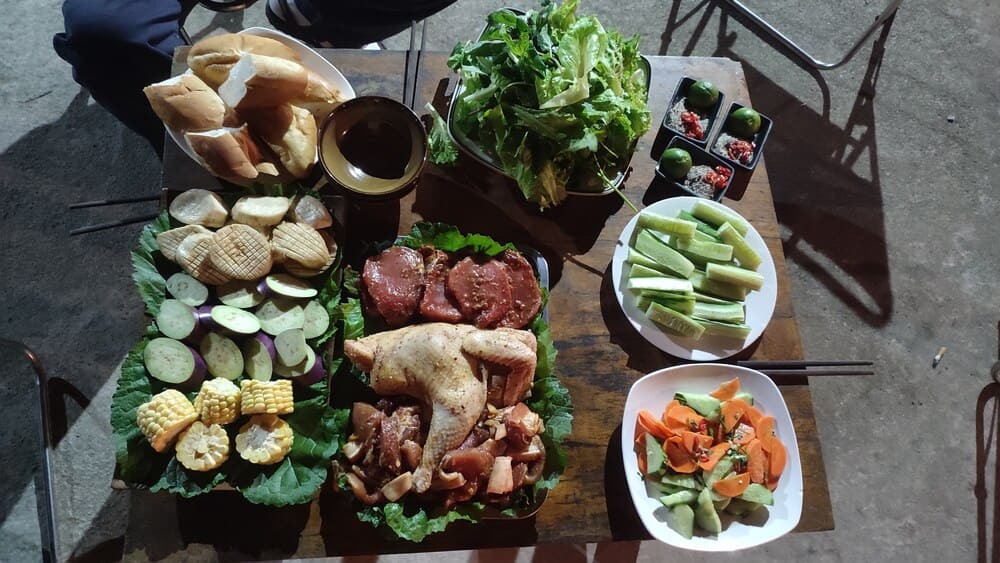
Navigation
Both Google Maps and Maps.me provide good navigation on the Ha Giang Loop. I used Maps.me as it’s a bit more detailed even without internet.
Ask your rentals for a smartphone stand (aka phone mount) for the motorcycle and do not use your smartphone while driving under absolutely no circumstances.
If you need to check the map, pull over, stop completely, and then figure out where the hell you’ve ended up.
When NOT to go on the Ha Giang Loop?
The rainy season hits Ha Giang in full force between June and September. Think of pouring rain, landslides, floods, and mud everywhere. It’s not an enjoyable experience, read about damage from 2022 here.
I strongly advise you to reconsider doing the Ha Giang Loop during the rainy season. The possibility that you have a miserable time is way too big. Yes, the weather is always unpredictable in Ha Giang, but don’t risk it with July and August.
…and when to go
On the flip side, the dry season in North Vietnam is between October and April. It can get cold in the winter in Ha Giang, thus the absolute best months to visit are October, November, March, and April.
I went in late February. The first day there was light rain, the second it was a bit misty and after that, I had some beautifully clear skies. The burning season does not affect Ha Giang all that much.
Ha Giang Loop Rapid Answers
How many days for the Ha Giang Loop?
Between 2 and 5. I suggest 4 days/3 nights.
How long is the Ha Giang Loop?
Between 310 and 450 km depending on your route. The standard route of Ha Giang -> Yen Minh -> Lung Cu -> Dong Van -> Meo Vac -> Du Gia -> Ha Giang is around 370 km.
How to get to Ha Giang from Hanoi?
Book a sleeper-style bus (day or night) from any hostel or tour operator for ~250.000 VND / 10.7$.
How to get to Ha Giang from Sapa?
There’s a daily minibus from Sapa to Ha Giang for 300.000 VND / 12.7$.
How hard is the Ha Giang Motorcycle Loop?
It’s hard and that’s the beauty of it. Don’t underestimate the roads nor overestimate your abilities or the bike’s capabilities.
If you want an easier motorcycle ride to warm you up, do the Hai Van Pass between Da Nang/Hoi An and Hue.
Can you do the Ha Giang Loop as a beginner?
Technically yes, but I strongly, STRONGLY advise you to take an easy rider.
Can I drive on the Ha Giang Loop without a driving license?
Legally no, but many do anyway. The penalty, if the police stop you, ranges from a small fine (i.e. a bribe) to bike impounding and potentially even more serious consequences.
Can you do the Ha Giang Loop by car?
Yes, but the true magic is on the back of a motorcycle. If you can’t drive yourself, take an Easy Rider.
Can you do the Ha Giang Loop by public transport?
Yes, but it’s not a lot of fun. There are minibuses between Ha Giang and Dong Van, and also between Dong Van and Meo Vac, and from Meo Vac to Ha Giang.
However, getting anywhere off-path is very difficult, and stopping for pictures is obviously out of the question.
Can you do the Ha Giang Loop on a scooter?
It is possible, but a semi-automatic bike is a much better and safer option. Changing gears helps you with both going up and down steep slopes.
The engine helps keep the brakes from overheating and the foot-operated brake gives one of your hands a rest from the brakes.
What bike to rent on the Ha Giang Loop?
Honda Blade 110 CC is the most popular bike and powerful enough to get you anywhere hassle-free.
Which months to avoid for the Ha Giang Loop?
July and August have the most rain and the biggest chance of landslides and floods.
What clothes to pack for the Ha Giang Loop?
Waterproof jacket, raincoat, blouse of some sort, long pants, closed shoes you don’t mind getting extremely dirty.
How much money for a 4-day self-organized Ha Giang Loop?
Around 2.500.000 VND (106$). This amount includes everything and is entirely based on my experience. See my full budget in Vietnam breakdown for a better idea of prices in Vietnam.
Check out my guides about these other motorcycle rides in Southeast Asia:
- Hai Van Pass
- Bolaven Plateau Loop (Pakse Loop)
- Thakhek Loop
